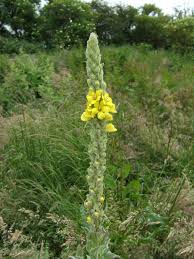Verbascum thapsus (great mullein or common mullein) is a species of mullein native to Europe, northern Africa, and Asia, and introduced in the Americas and Australia.
Contents
Uses
Mullein is used for cough, whooping cough, tuberculosis, bronchitis, hoarseness, pneumonia, earaches, colds, chills, flu, swine flu, fever, allergies, tonsillitis, and sore throat. Other uses include asthma, diarrhea, colic, gastrointestinal bleeding, migraines, joint pain, and gout. It is also used as a sedative and as a diuretic to increase urine output.
Mullein is applied to the skin for wounds, burns, hemorrhoids, bruises, frostbite, and skin infections (cellulitis). The leaves are used topically to soften and protect the skin.
In manufacturing, mullein is used as a flavoring ingredient in alcoholic beverages.
Benefits
Mullein tea is a traditional treatment for respiratory problems, such as chest colds, bronchitis and asthma. Mullein leaf tea is slightly bitter; a tea of the flowers is sweeter. Both the leaves and flowers contain mucilage, which is soothing to irritated membranes, and saponins, which make coughs more productive. Research has shown that the herb has strong anti-inflammatory activity, and lab studies suggest that mullein flower infusions have antiviral properties, as well.
Many of mullein’s traditional medicinal uses were similar throughout the Old and New World, but whether European settlers learned to use the herb from Native Americans or vice versa is open to debate. Besides using mullein leaf and flower teas to treat respiratory problems, some Native Americans also used the plant’s roots. The Creek Indians drank a decoction of the roots for coughs; other tribes smoked the roots or dried leaves to treat asthma.
Topical applications were equally varied. The Cherokee rubbed mullein leaves in their armpits to treat “prickly rash.” Leaf poultices were used to treat bruises, tumors, rheumatic pains and hemorrhoids. Mullein flower oil (made by steeping the flowers in warm olive oil) also has been used for treating hemorrhoids, as well as earaches.
Mullein leaves have been used in cosmetic preparations to soften skin. “Quaker rouge” refers to the practice of reddening cheeks by rubbing them with a mullein leaf. And a yellow dye extracted from the flowers has been used since Roman times as a hair rinse as well as to dye cloth.
Caution
Mullein is POSSIBLY SAFE for when applied to the ear, short-term. A specific product (Otikon Otic Solution, Healthy-On Ltd.) that contains mullein, garlic, calendula, and St. John’s wort has been used in the ear for up to 3 days.
Special Precautions & Warnings:
Children: Mullein is POSSIBLY SAFE when applied to the ear, short-term. A specific product (Otikon Otic Solution, Healthy-On Ltd.) that contains mullein, garlic, calendula, and St. John’s wort has been used in the ear for up to 3 days.
Pregnancy and breast-feeding: There is not enough reliable information about the safety of taking mullein if you are pregnant or breast-feeding. Stay on the safe side and avoid use.
Interactions
None are recorded.
Other names
Aaron’s Rod, Adam’s Flannel, American Mullein, Beggar’s Blanket, Blanket Herb, Blanket Leaf, Bouillon Blanc, Bouillon Jaune, Candleflower, Candlewick, Cierge Cotonneux, Cierge de Notre-Dame, Clot-Bur, Clown’s Lungwort, Cuddy’s Lungs, Duffle, European Mullein, Faux Bouillon-Blanc, Feltwort, Flannelflower, Fleur de Grand Chandelier, Fluffweed, Gidar Tamaku, Gordolobo, Hag’s Taper, Hare’s Beard, Hedge Taper, Herbe de Saint-Fiacre, Herbe Saint Fiacre, Higtaper, Jacob’s Staff, Longwort, Molène, Molène à Grandes Fleurs, Molène Bouillon-Blanc, Molène Faux-Phlomis, Molène Thapsus, Orange Mullein, Oreille de Loup, Oreille de Saint Cloud, Our Lady’s Flannel, Queue de Loup, Rag Paper, Shepherd’s Club, Shepherd’s Staff, Tabac du Diable, Torch Weed, Torches, Velvet Plant, Verbasci Flos, Wild Ice Leaf, Verbascum densiflorum, Verbascum phlomides, Verbascum thapsiforme, Verbascum thapsus, Woolen, Woolly Mullein
Reference
Source: WebMD, http://www.webmd.com/vitamins-supplements/ingredientmono-572-mullein.aspx?activeingredientid=572&activeingredientname=mullein
Motherearthliving, http://www.motherearthliving.com/plant-profile/herb-to-know-mullein-verbascum-thapsus.aspx
Wikipedia, https://en.wikipedia.org/wiki/Verbascum_thapsus

